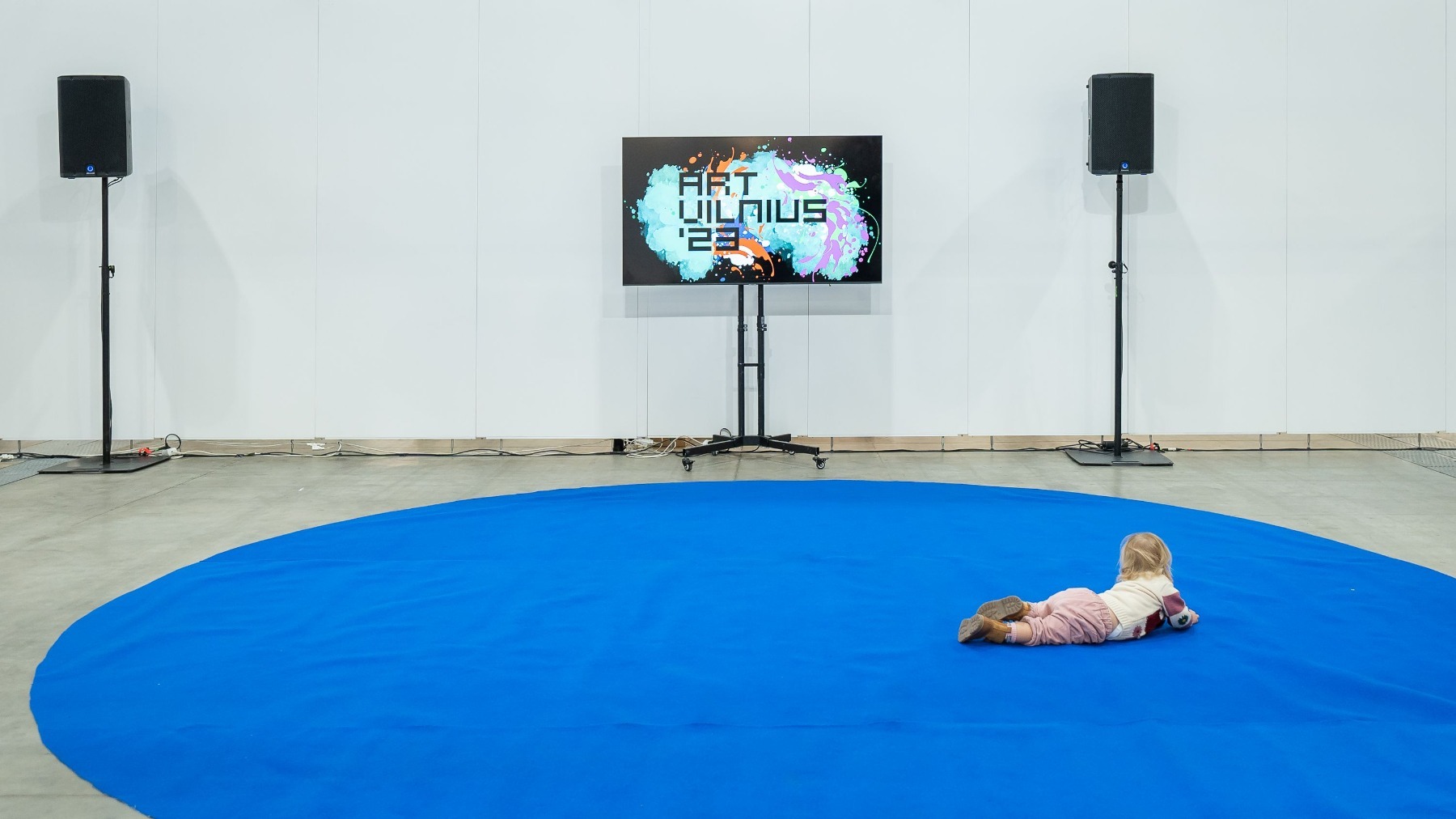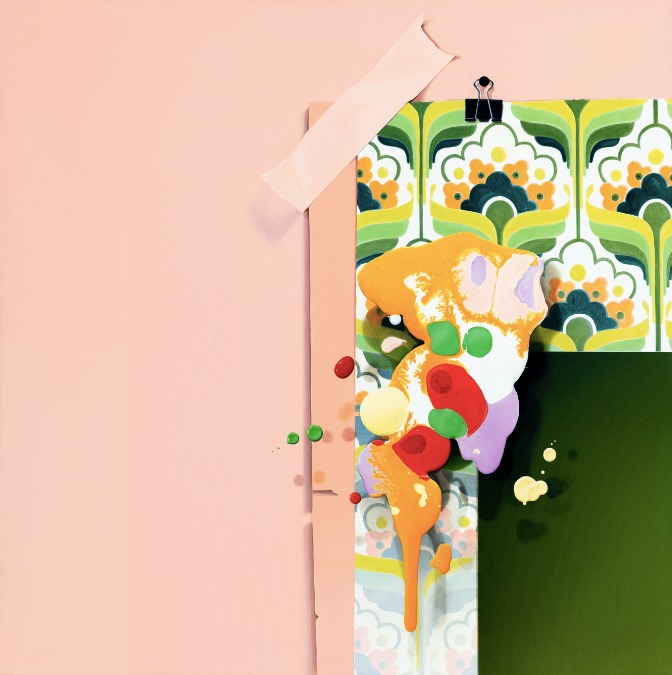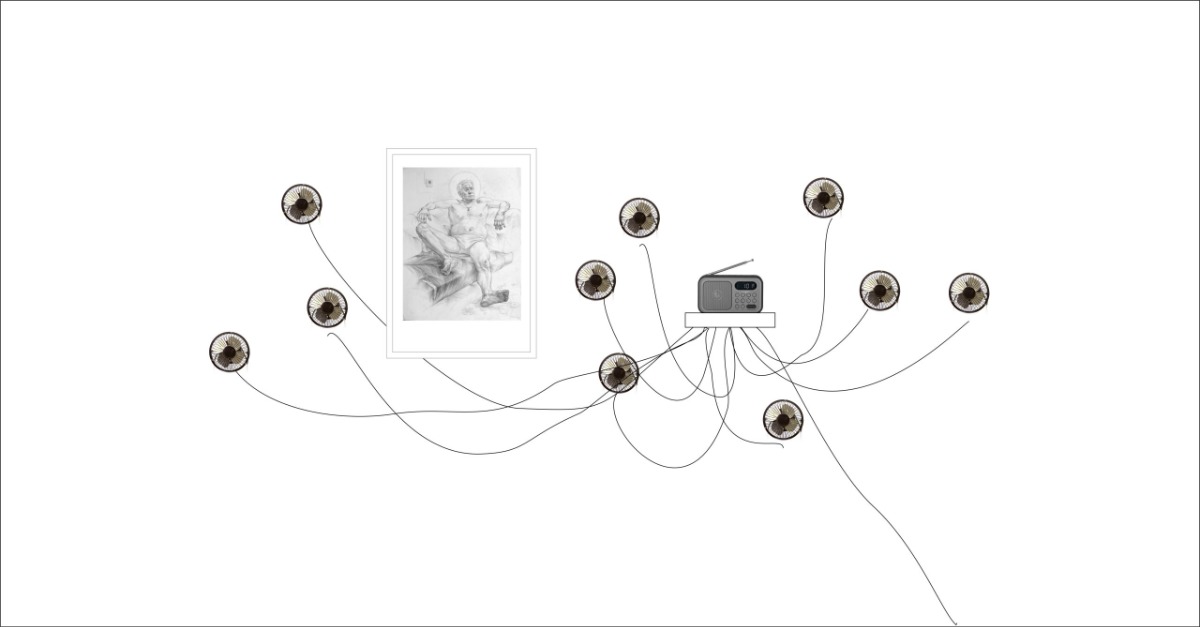
ArtVilnius’23. Art against a backdrop of current news
Paulis Liepa was named Best Artist at the ArtVilnius’23 contemporary art fair that ran from 13 to 15 October 2023 at the Litexpo exhibition centre, bringing together 70 art galleries and around 300 artists from 18 countries.
The largest contemporary art fair in the Baltic region, Art Vilnius has successfully forged long-term links with galleries based not just in Lithuania but also Latvia and Estonia. Thus, the Riga Māksla XO gallery has been taking part in the art fair for several years now; this time around, its efforts resulted in considerable success: the international panel of experts duly appreciated the minimalist and conceptually well-considered exhibition of works by Paulis Liepa presented at the gallery’s booth. Paulis was named Best Artist of ArtVilnius’23; this is how the Lithuanian artist Raminta Jurėnaitė, a member of the jury, summed up the opinion shared by her fellow experts: ‘His work combines classical printmaking techniques, woodcuts, and metaphors of building plans, manuscripts, and archives. The seemingly minimalist works have many nuances and connotations. It is art that balances between geometric abstractions and conceptual art in a unique and sensitive way.’
Fragment from Paulis Liepa's exhibition at the Māksla XO gallery stand at the ArtVilnius'23. Photo: Sergej Timofejev
Paulis Liepa. Photo: Audrius Solominas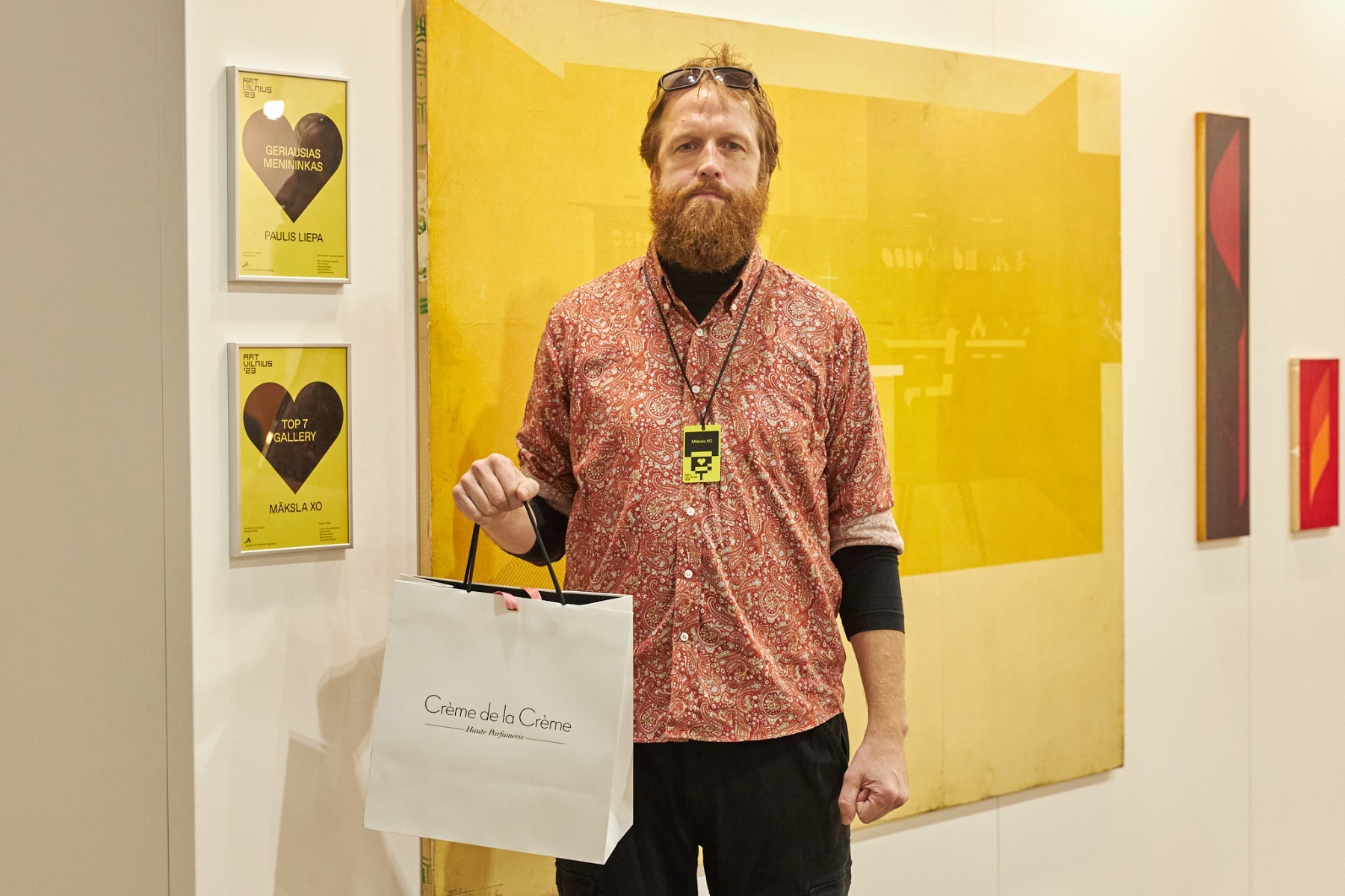
During our conversation on the sidelines of the art fair, the art director of the event Sonata Baliuckaitė likewise expressed appreciation for the gallery’s approach: ‘Last year the gallery presented Ieva Iltnere; this year it was Paulis Liepa. And it is a very solid approach, choosing and presenting a single artist. It may complicated things sales-wise. On the other hand, it makes it easier for the jury to appreciate the presented artist. I am genuinely pleased with this decision; I have seen Paulis’ works at other art fairs, in Vienna and Berlin. His art is defined by a very profound and professional approach. Professionalism was also the main yeardstick the experts used when picking the Best Young Artist. The works by Julija Skudutytė presented by Užupis Art Incubator are quite ironic but they are first and foremost truly high quality pastels.’
Visitors at the stand of the Pilot Gallery at the work of Jūlija Šilova. Photo: Andrej Vasilenko 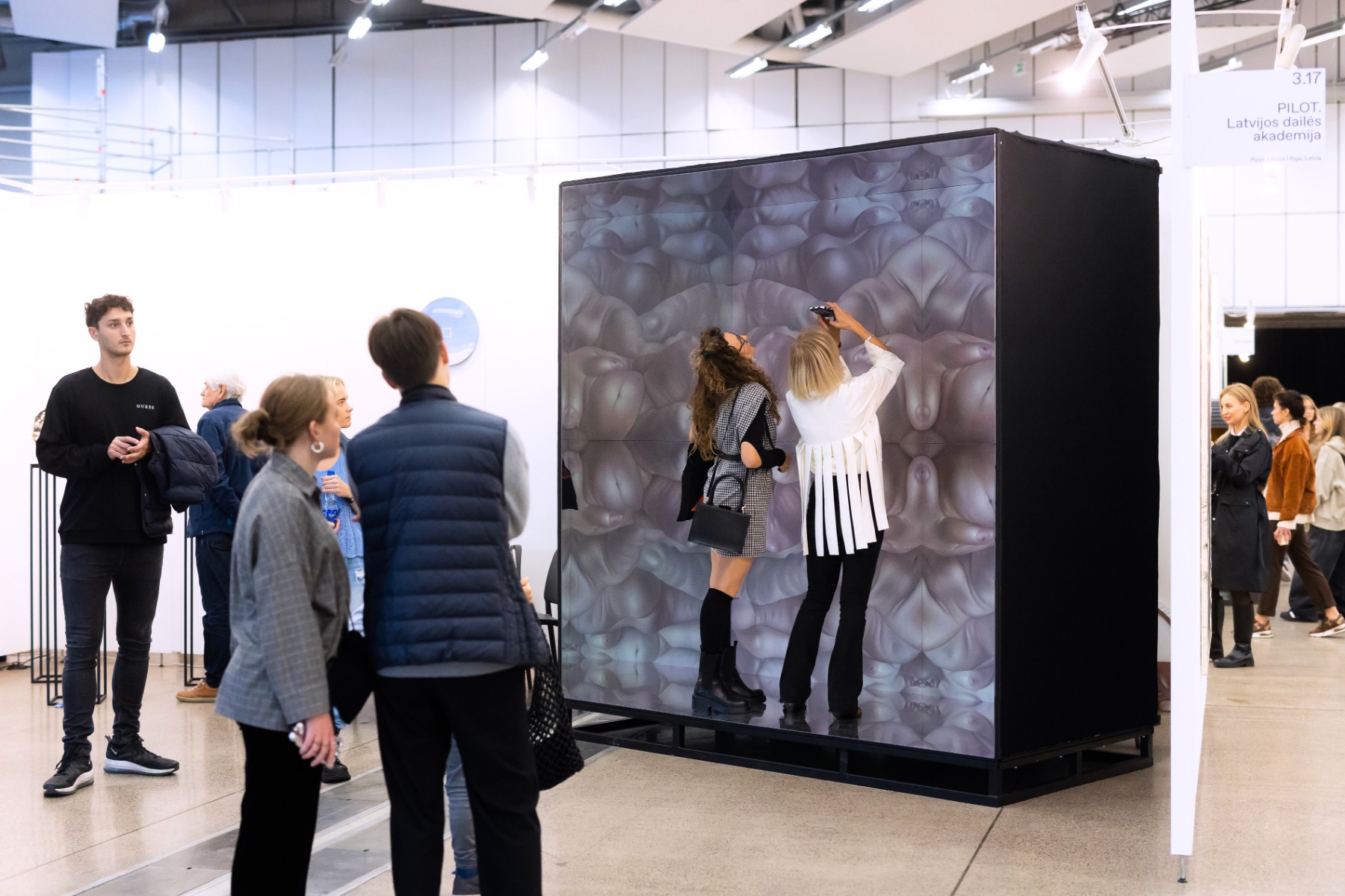
Incidentally, a member of the panel of experts emphatically argued for singling out a piece by another Latvian artist, Jūlija Šilova, whose impressive ‘Semantic Satiation’, part of the presentation by the Pilot Gallery representing works by undergraduate and graduate students of the Latvian Academy of Arts, constantly attracted small crowds of viewers. According to Jūlija, her work is a reflection on the countless hours spent at life drawing, an important part of the learning process at the Academy, where the artist inevitably eventually stops associating the sitter’s body with a live human being: it becomes an abstract set of shapes. The work is a structure filled with paintings of the body of one particular female sitter, while the built-in mirrors transforms this corporeality into a striking rosy-bluish ‘adult’ kaleidoscope.
Maarit Murka. Crystal 7. 2023. At the MENO NIŠA gallery stand (Vilnius)
Kim? Contemporary Art Centre stand. Photo: Andrej Vasilenko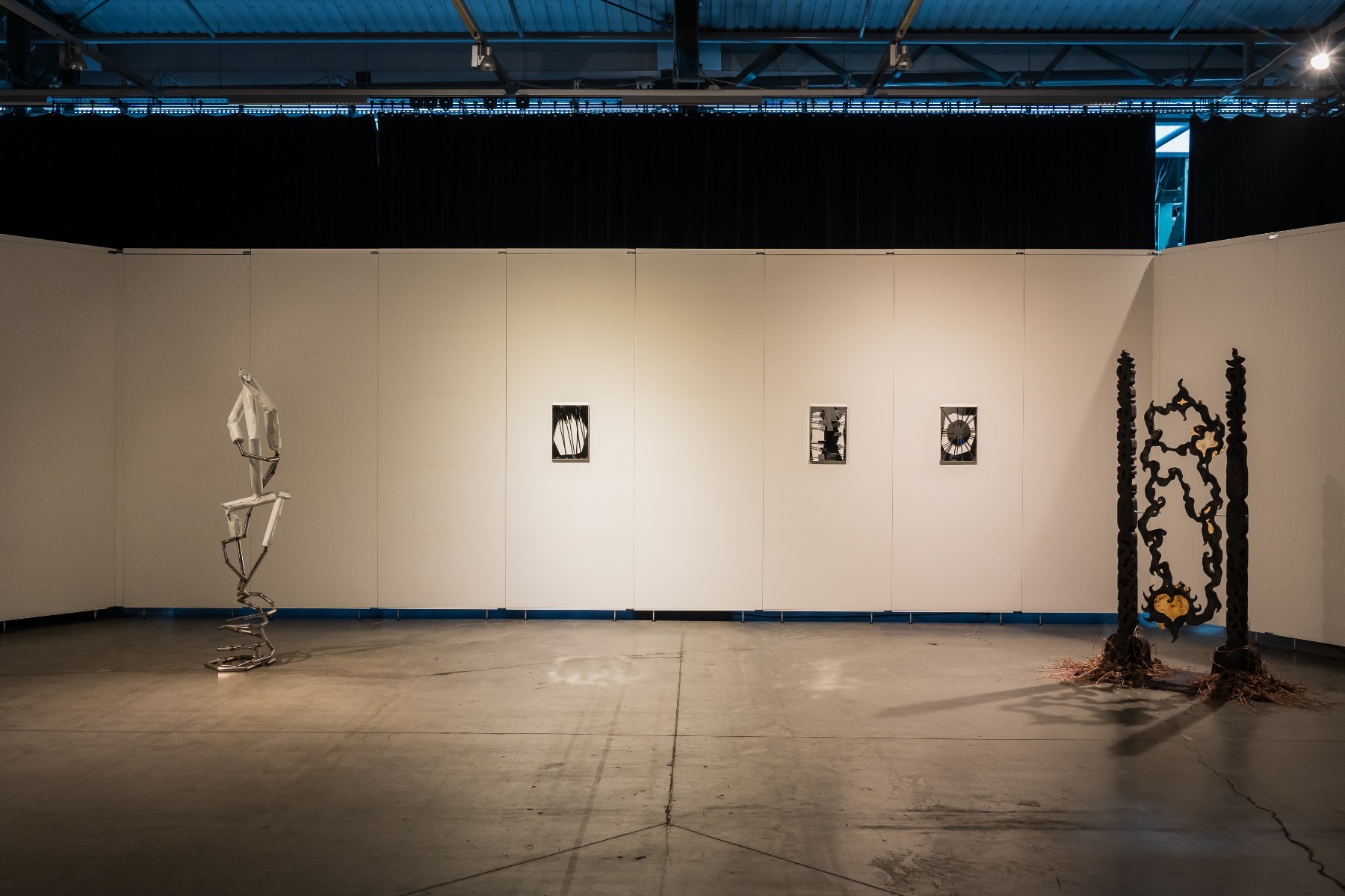
In the non-commercial Project Zone, curated by Valentinas Klimašauskas for the second year running, Latvia was also represented by the Kim? Centre for Contemporary Art showing a small selection of works by Indriķis Ģelzis (it was announced last weekend that his solo exhibition, which just finished its run at the Kim? centre, was nominated for the 2025 Purvītis Prize). Meanwhile, Agija Sūna’s Art Gallery performed convincingly among commercial galleries, showing works by three artists working in painting: Dita Lūse, Irēna Lūse and Gita Šmite.
‘Live installation’ entitled ‘Pregnant Silence’ by Aira Naginevičiūtė and performers of the Airos Theatre. Photo: Andrej Vasilenko 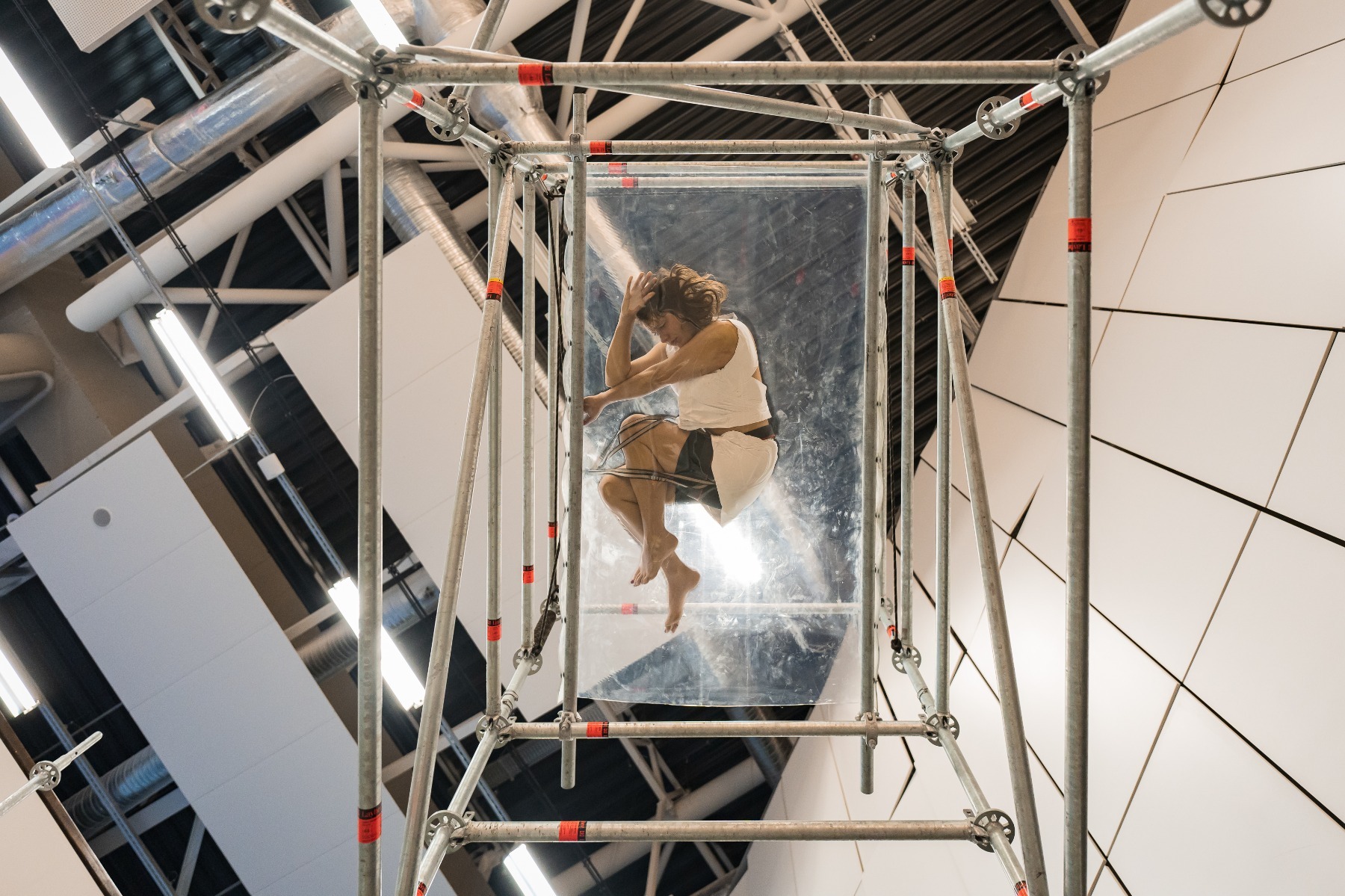


On the whole, the main emphasis at this edition of the art fair was on performativity. To some extent, this may have been the effect of the Vilnius Biennial of Performance Art that took place in the Lithuanian capital this summer. Performances were presented both in a special auditorium and as sporadic ‘eruptions’ in the booths of the art galleries. One of the performances was actually a perpetual presence at the art fair: on transparent surfaces secured on metallic scaffolding-like structures, performers of the Airos Theatre were lying down, stretching and very slowly, almost imperceptibly moving within a ‘live installation’ by the guru of Lithuanian contemporary dance Aira Naginevičiūtė entitled ‘Pregnant Silence’. The performance provided an excellent counterpoint to the noisy and bustling anthill of the exhibition.
There was no shortage of visitors, particularly over the weekend. People seemed to be keen to switch to a different mode, temporarily escape the heartbreaking stream of news of the global current events. ‘What people are hoping to find in art these days is some serenity, a sense of tranquillity – or perhaps they are looking to block out in their mind the footages seen in the news with the help of images made up by artists,’ says Sonata Baliuckaitė.
Žygimantas Augustinas. The Cooling Radio. 2023. Photo: Andrej Vasilenko 
In this sense, one of the installations presented as part of the non-commercial Takas (Paths) programme could serve as an excellent illustration of this desire (the works of the programme were shown in various areas of the art fair): ‘The Cooling Radio’, dreamed up by Žygimantas Augustinas, is an ordinary radio set connected to 10 mini fans. The more active the music and voices on any given radio station, the faster the fans turn, as if attempting to cool off and balance our perception. ‘The piece is inspired by the heated domain of information. News and announcements are constantly attacking us to the point that the information has become a continuous noise. Its ever-growing tension may only be cooled by the wind,’ it says in the annotation to the work.
Dmytro Kurovskiy. School of Elegance. 2020. At the RA Gallery (Кyiv) stand
However, the art fair does not avoid matters of solidarity. ‘We do not feature a special guest country this year. We did, however, provide very special conditions for four participating art galleries from Ukraine: they take part free of charge, we take care of the logistics, etc. And we are very happy for this opportunity to show our support to our Ukrainian colleagues. There is also a gallery from Vienna taking part in the art fair that represents young artists from Ukraine,’ says Sonata Baliuckaitė.
A fragment of Barbora Gediminaite’s artwork at the Foreign Territory gallery stand. Photo: Arterritory.com
There are also some works that reflect the reality of a distant war – or perhaps our perception of it. Like the Afghan rug patterns cut out of mirror – the motifs of tanks, planes and helicopters in Barbora Gediminaite’s work at the booth of the Foreign Territory Gallery (New York / Vilnius). ‘The idea of mirror installation is self-reflection. You watch at it and you see your reflection. But also these mirrors reflect the reality of people who wove these carpets,’ the artist explains.
‘Bleeding Dry’ installation by the German artist Mara Kirchberg at the stand of the Tallinn Uus Rada Gallery. Photo: Arterritory.com 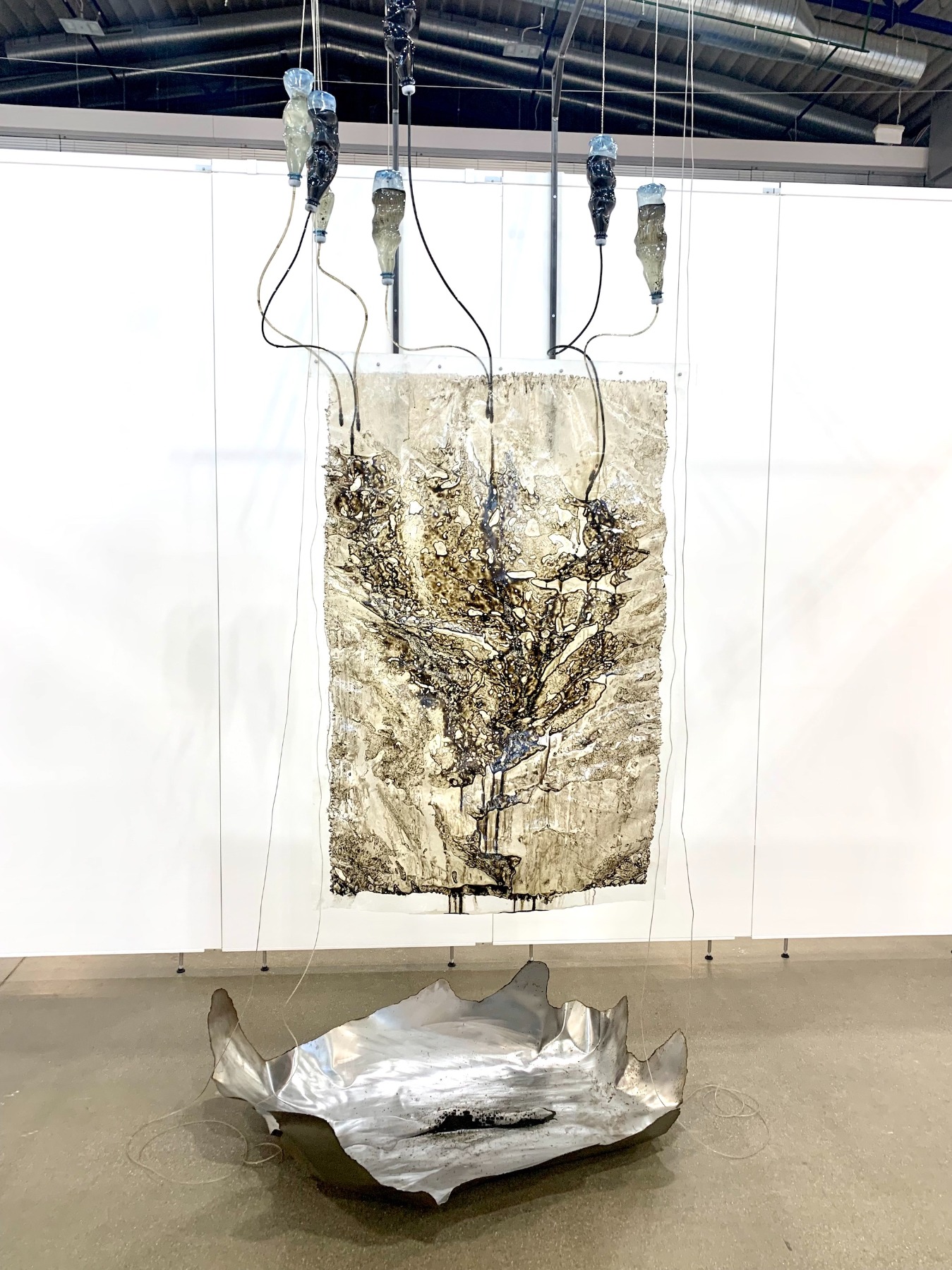
Another hot global topic, environment, can be explored through the lens of the relationship between machines and the organic world. A work deserving a special mention in this respect is the ‘Bleeding Dry’ installation by the young German artist Mara Kirchberg shown at the booth of the Tallinn Uus Rada Gallery, an artist-run space representing students of the MA Contemporary Art programme (MACA) at the Estonian Academy of Arts (EKA). ‘The central element of the work is an empty gutted membrane that is being fed with engine oil and coolant. What is usually used to keep a system running, finds its comfort in oozing, dripping and leaking through an artificial transparent membrane. While putting the viewer in a total loss scenario, a closer look simultaneously reveals an inner life and functioning allowing for associations to unknown anatomies, eczemas, blood cells and other microorganisms. In an ultra-slow pace, the fluids continuously generate familiar yet strange biomorphic forms and new organs that seem to last although gravity dooms them to vanish over time,’ says the annotation to the piece. ‘It's kind of a living sculpture that also needs maintenance every day,’ Mara told me. ‘I have a background in choreography and performance. So I've been very busy with the body and bodily functions and what happens when the body doesn't function anymore. I came to combine bodily function and industrial machinery function. I mainly work with medical materials, sanitary materials and materials that come from car workshops. I try to find the aesthetic in something that is very dirty and very smelly, to find some physical organic structures in something very artificial.’
In a sense, this markedly slow, almost imperceptible oozing of the drops of used oil mixed with water resonated with the above mentioned ‘Pregnant Silence’ performance by Aira Naginevičiūtė. A different sense of time, different physiology of time amidst the art fair space packed with people and events.
Katrin Piile. An Idyll No.3. At the TÜTAR GALLERY stand (Таllinn)
Incidentally, an Other or an Alter Ego has emerged for ArtVilnius this year. Artists (who are, by the way, also participating in the ArtVilnius’23 programme) Robertas Narkus and Laura Kaminskaitė became initators of a ‘parallel’ art fair, Komisas, taking place in the galleries of Tech Zity Vilnius, a new centre for IT- and art-related activities in the city. Over 30 artists chose to participate in the event where they made their own decisions regarding the matters of selecting, exhibiting and pricing their works. ‘Such a model could perhaps make galleries worried, after all, in these times of opportunities offered by social networks and blockchains, the work of gallerists is always complicated and so full of challenges. However, we do not pursue provocations, Komisas is a celebration of the expanding community, which aims to look more freely at the taboos surrounding the art field,’ stated Robertas Narkus.
Indrė Rybakovaitė. Riga Aviation Museum. 2023. Akademija gallery (Vilnius)
When I asked Sonata Baliuckaitė about her and her colleagues’ opinion regarding the event, she told me: ‘We are really happy about it: in all big European cities who have art fairs, Paris, Berlin and London, there are four or five fairs during the same time. Of course, I cannot say that it's the same format fair because the participants of Komisas are artists and mostly young artists, but we prefer this classical format with galleries as participants. It’s nice to have some movements in the city in the same time. It’s good news.’
Marija Griniuk, an artist living in Norway, not only performed several performances at the fair, but also exhibited a video of her performance at the Riga performance festival Starptelpa. Photo: Andrej Vasilenko 
Undoubtedly, art life in Vilnius this year has been consistently gaining momentum. New institutions, new art spaces, new initiatives have been emerging, supported by the city’s enthusiastic response to its own 700th anniversary celebrations. Viewed in this context, ArtVilnius has the image of a multilevel event with a well-established reputation. In reality, its history is dating back to a not-so-distant past: the first edition of the art fair took place in 2009. ArtVilnius has truly managed to become a leading event of this kind in the region. As for hopes for the future, it would be great to see more galleries from the neighbouring Poland or the slightly more distant Czechia here: there is still plenty of room for growth left for ArtVilnius.
Work by Vytautas Tomaševičius at the Galerija MOrka stand (Vilnius). Photo: Arterritory.com 
Audrius Janušonis. Best Band Ever. 2022–2023. At the non-commercial Takas (Paths) programme. Photo: Andrej Vasilenko 
Photo: Andrej Vasilenko